Table of contents:
Tunisia 2009
Socio-economic indicators
| HDI: | 0.705 | Life expectancy at birth: | 74.2 | GNI: | 7,920 | |||||||||||||||||||
Source: UNDP.
Figure 1: Persons with disabilities
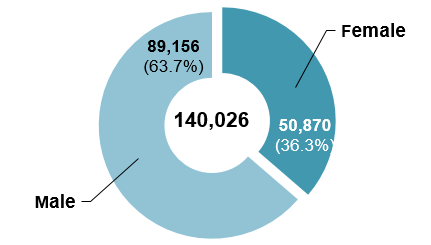
| Female | Male | Total |
| 36.3% | 63.7% | 100.0% |
| 50,870 | 89,156 | 140,026 |
Figure 2: Total population
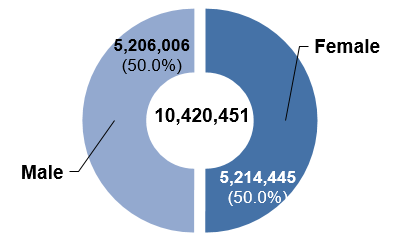
| Female | Male | Total |
| 50.0% | 50.0% | 100.0% |
| 5,214,445 | 5,206,006 | 10,420,451 |
Figure 3: Age-specific prevalence of disability (in percentage)

| Female | Male | Total | |
| 0-14 | 0.5 | 0.6 | 0.6 |
| 15-24 | 1.0 | 1.5 | 1.3 |
| 25-44 | 1.0 | 2.1 | 1.5 |
| 45-64 | 1.1 | 2.2 | 1.6 |
| 65+ | 2.1 | 3.4 | 2.7 |
| Total | 1.0 | 1.7 | 1.3 |
Figure 4: Age distribution of persons with disabilities (in percentage)

| Female | Male | Total | |
| 0-14 | 12.4 | 9.0 | 10.2 |
| 15-24 | 18.6 | 17.9 | 18.2 |
| 25-44 | 33.2 | 36.2 | 35.1 |
| 45-64 | 21.1 | 23.1 | 22.4 |
| 65+ | 14.7 | 13.8 | 14.1 |
Type of disability / difficulty (in percentage)
| Female | Male | Total | |||||||
|
Physical disability |
34.3 | 38.0 | 36.7 | ||||||
|
Mental disability |
29.5 | 28.5 | 28.9 | ||||||
|
Visual disability |
9.1 | 10.5 | 10.0 | ||||||
|
Hearing disability |
5.8 | 4.7 | 5.1 | ||||||
|
Speech disability |
5.6 | 4.1 | 4.7 | ||||||
|
Speech and hearing disability |
4.8 | 3.0 | 3.7 | ||||||
|
Multiple disabilities |
6.3 | 5.6 | 5.8 | ||||||
|
Mental illness |
4.6 | 5.5 | 5.2 | ||||||
Cause of disability / difficulty (in percentage)
| Female | Male | Total | |||||||
|
Since birth |
57.3 | 48.3 | 51.6 | ||||||
|
Chronic disease |
24.2 | 24.8 | 24.6 | ||||||
|
Occupational disease |
0.4 | 1.7 | 1.2 | ||||||
|
Work-related accident |
1.1 | 6.1 | 4.3 | ||||||
|
Road traffic accident |
1.8 | 4.7 | 3.7 | ||||||
|
Home accident |
4.1 | 3.1 | 3.5 | ||||||
|
Other accident |
2.8 | 4.3 | 3.8 | ||||||
|
Old age |
4.7 | 2.7 | 3.5 | ||||||
|
Other causes |
3.4 | 4.1 | 3.8 | ||||||
|
Not specified |
0.2 | 0.2 | 0.2 | ||||||
Figure 5: Persons with disabilities by geographical location (in percentage)
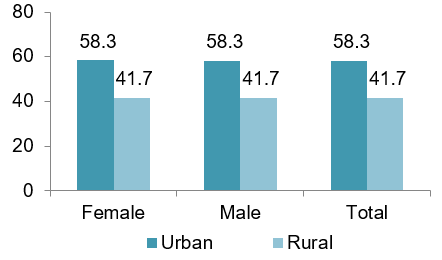
| Female | Male | Total | |
| Urban | 58.3 | 58.3 | 58.3 |
| Rural | 41.7 | 41.7 | 41.7 |
Figure 6: Total Population by geographical location (in percentage)
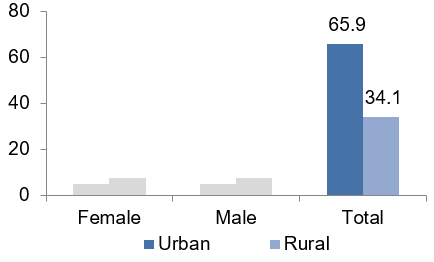
| Total | |
| Urban | 65.9 |
| Rural | 34.1 |
Figure 7: Total population (15 years and above) by marital status (in percentage)
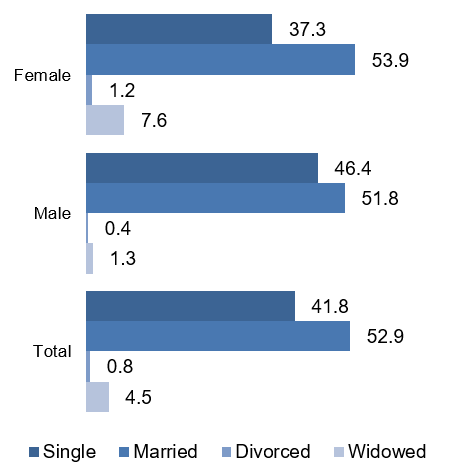
| Female | Male | Total | |
| Married | 53.9 | 51.8 | 52.9 |
| Single | 37.3 | 46.4 | 41.8 |
| Widowed | 7.6 | 1.3 | 4.5 |
| Divorced | 1.2 | 0.4 | 0.8 |
Total population (10 years and above) by educational attainment (in percentage)
| Female | Male | Total | |||||||
|
None |
26.6 | 12.2 | 19.4 | ||||||
|
Primary |
30.9 | 36.1 | 33.5 | ||||||
|
Secondary |
32.2 | 40.0 | 36.1 | ||||||
|
Higher education |
10.0 | 11.5 | 10.8 | ||||||
|
Not specified |
0.2 | 0.2 | 0.2 | ||||||
Figure 8: Total population (15 years and above) by economic activity (in percentage)

| Female | Male | Total | |
| Employed | 20.1 | 61.0 | 40.3 |
| Unemployed | 4.7 | 7.7 | 6.2 |
| Not economically active | 75.2 | 31.3 | 53.5 |
Source: National Institute of Statistics (2009).
SIGNATURE / RATIFICATION OF THE CONVENTION ON THE RIGHTS OF PERSONS WITH DISABILITIES & ITS OPTIONAL PROTOCOL |
||||
|
Convention |
Signed |
30.3.2007 |
Ratified / Acceded |
2.4.2008 |
|
Optional Protocol |
Signed |
30.3.2007 |
Ratified / Acceded |
2.4.2008 |
Source: UN (2014).
NATIONAL INSTITUTIONAL FRAMEWORK FOR DISABILITY / PERSONS WITH DISABILITIES |
||
|
National coordination mechanism: |
Name: |
Higher Council for Social Development and for the Welfare of Disabled Persons |
|
Year established: |
2010 |
|
|
Chair: |
Prime Minister |
|
|
Persons with disabilities represented? |
Yes |
|
|
Additional mechanisms: |
System of focal points for disability related matters in line ministries or other governmental institutions |
|
|
The Higher Committee for Human Rights and Basic Freedoms |
||
NATIONAL DEFINITION OF DISABILITY / PERSONS WITH DISABILITIES |
|
NATIONAL LEGISLATIVE FRAMEWORK FOR DISABILITY / PERSONS WITH DISABILTIES (YEAR OF ADOPTION) |
|
|
Articles on disability included in the constitution? |
CBD |
|
General / overarching national disability law |
Directive No. 83 on the Advancement and Protection of Disabled Persons (2005) |
|
National disability strategy / plan |
Sectoral strategies1 |
Source: ESCWA, based on data collected from government focal points through the ESCWA Questionnaire on the Implementation of the Convention on the Rights of Persons with Disabilities and the Arab Decade for Persons with Disabilities (2013).
Footnotes:
1 National Plan for the Prevention of Disability, National Strategy for Inclusion of Disabled Persons in Schools, National Plan for the Employment of the Disabled and National Plan for Space Modification.